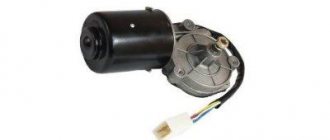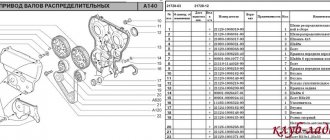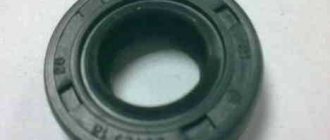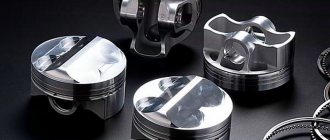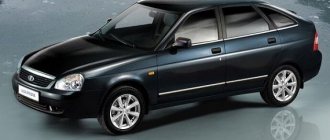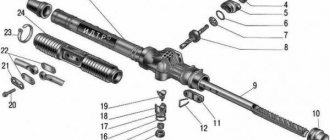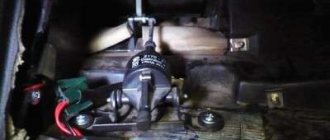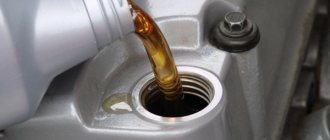I decided to talk about the grooves on the top of the piston group - in more detail. Namely, how does this whole thing work and is it necessary to install such types on your car - or can you drive with ordinary ones and not worry? To begin with, I will describe the piston itself.
Housing and structure
It is an almost exact copy of a regular car piston, with only one distinctive feature - in the upper part, instead of the usual “mirror,” special recesses appear to increase the service life of both some timing parts and the pistons themselves.
Reasons for installation
Here guys, everything is individual, as I have already written in many articles, if you follow the technical maintenance regulations, install original or high-quality spare parts, then your “iron horse” will not let you down - the units will operate in normal modes.
However, you always want to save money or tune up your car, but this raises some questions. Namely:
1) If we save, in particular, on the timing system (belt and other rollers) by installing low-quality parts, then their replacement interval drops significantly. For example, as a standard on our VAZs, the timing belt is changed after about 30 - 50,000 km, but if cheap "non-original" ones are installed, it can last about 5,000 - 10,000 km, or maybe less.
2) Also, some “people’s tuners” who try to squeeze more power out of our PRIORs often install air compressors on the engines. But most of the parts are not designed for such speeds (7000 - 9000), just as the gas distribution system is not designed. As you guessed, the connecting link of the belt simply breaks.
So what should we do? After all, you want to save money and drive? There is a solution (damn, just like in the advertisement) - “stickless pistons”!
Groove on top
To call them plug-free is not literary, but in a “garage” way - they will immediately understand you and appreciate your technical potential! This name comes from a simple trick - the piston does not meet the valve with the help of a special groove on top - that is, the valve DOESN'T fit into the piston, that's the name.
However, if you tell it technically and literary correctly, it turns out that there are several grooves in the upper part of the piston. Their number can be different - from 2 to 4 pieces. It is thanks to these grooves that these two engine elements do not meet. That is, the correct name is a piston with grooves.
pros
Needless to say, this system is very durable. Even if your timing belt breaks and the overhead camshaft with a set of valves freezes in place.
If the piston comes from below, pushed by the crankshaft, then no disaster will happen - they will simply fall into the grooves and everything will be fine.
That is, we just take the car to the service station, they restore the timing mechanism and you drive on. A VERY big plus.
I would like to note right away that if there are no such grooves, then you are faced with a very unpleasant repair. You can change the pistons, and the camshaft pastel; I’m already silent about the timing belt with all that it implies.
Repairs, for example, on a foreign car of class “C” or “D” can vary from 30,000 rubles and more! That’s why many people think about installing “stickless” pistons; they sleep more peacefully - well, the system breaks down, so what, the grooves will save them.
But if you think about the disadvantages, they also exist and for many manufacturers they are significant!
Minuses
When many AvtoVAZ engines appeared for front-wheel drive cars, engineers equipped the pistons with such grooves from the factory. That is, this resource was already included in production, such tuning was associated with installing a timing belt instead of a chain, and since it is less reliable, they were simply insured. This was the case with many foreign cars of those times (not all, but a large number).
However, nothing stands still, everything develops. So we got to the piston itself, the fact is that if you lighten it as much as possible, the engine gains additional power, as some manufacturers assure you can achieve about 5 - 7% of the power, this is very significant!
1) The piston with a groove cannot be called light! In order to go deeper in the top (to make grooves) you need to have a thick top, which significantly makes the piston heavier, which consequently removes power.
Which pistons are better to put on the Lada Priora - choice of plugless pistons
Even for a relatively recent owner of this car brand, replacing pistons on a Priora with plug-in ones quickly becomes tempting and attractive.
Everyone is too frightened by the numerous horror stories about the consequences of a broken timing belt. And they are very sad: as a result of the meeting of pistons with valves, the engine suffers significant damage, which can only be eliminated through a major overhaul with the replacement of a huge number of parts.
Replacing the pistons on the Priora with plug-in ones completely eliminates the possibility of valves and pistons meeting. The grooves on the latter are quite deep, and if the unfortunate belt breaks, they can easily prevent catastrophic consequences.
Plugless pistons for Lada Priora – which ones to choose
Important to know: The choice is, of course, yours, but our recommendation is to avoid STI. Not everything is clear about the price of these non-plug-in devices: in some areas they are the cheapest, in others they are more expensive than even the Avtramat. However, you should not be tempted by the low cost - no matter how soon you will have to buy new ones.
There are 3 varieties available on the Russian market. STI. Produced by hot pressing.
- Prior is not very well approved by its owners. Firstly, their compression ratio is rather low, and secondly, the combustion chamber area is too large. This affects the efficiency of the engine towards its reduction. In addition, the alloy from which they are made has a reduced silicon content (which makes the pistons less resistant to temperatures) and nickel (which reduces their service life). An additional disadvantage is that on cars with STI installed, breaks of the camshaft drive belt occur too often.
- “Avtramat” produced in Kharkov is made by casting. The pistons have a composition that exactly matches the Priorov ones. The compression has the calculated values, the efficiency, although reduced due to the increase in sampling areas, is insignificant - by 0.1 cm2.
- Samara. They have almost the same indicators as Avtramat. The Kharkov parts are inferior in weight: they are heavier (this is generally undesirable). But they win on price, since they cost a third less.
Video: STK plugless pistons and ShPG weight distribution
Non-stick pistons on a Priora 16 valves - comparative characteristics
Now I would like to talk to you about the comparative characteristics of the above-described plugless pistons:
Having a higher cost despite the indicated disadvantages, the STI forged piston loses to the Avtramat and STK. At the same time, there have been cases of breakage of the camshaft drive belt on Priors with STI pistons.
Video: Converting the Priora engine to plugless pistons
Support the site – Share the article on social networks:
How to change pistons on a Priora
The problem of a broken timing belt (gas distribution mechanism) and the valve system on the Priora has been discussed more than once. But at the same time one aspect was omitted. Often, during an impact, not only the valves, but also the pistons of the Priora are damaged. And they also have to be changed. And in general, this question, replacing the Priora pistons, is worth considering more closely.
Why change pistons?
There are three reasons that motivate a car owner to start such a global operation:
- Piston failure.
- Prudent replacement.
- Engine tuning.
Now we will briefly analyze these reasons.
Piston failure
Prudent replacement
Often, the prudent owner of the Priora, who is aware of this unpleasant feature of the VAZ 2170 engine and modifications, replaces the pistons in advance.
Engine tuning
This is mainly a youth option, although not 100%. Many people want to own a sports car. And at hand is a Priora. And here the tuning begins. There are many different techniques to increase engine power, and one of the mandatory ones is installing pistons of a different configuration.
Important! In any case, when replacing Priora pistons, it is necessary to install new pistons that have a special groove for the valves. This guarantees the safety of the gas distribution system in the event of a break in the timing belt.
Symptoms of malfunction and diagnostics of the piston group
Of course, if the pistons are destroyed after hitting the timing belt, then the car simply won’t start, that’s all.
But how to determine normal wear, or burnout of the piston, requiring its replacement? The first sign of possible wear of the piston group is a drop in engine power.
Of course, this could be a sign of many other problems. For example, fuel supply systems. But it won’t hurt to check the condition of the Priora pistons.
Even in modern times, the age of total computerization and widespread use of electronics, the condition of the pistons is checked with a good old compression meter. This is a pressure gauge equipped with a special valve that “collects” the pressure in the cylinders over several strokes.
How to measure the compression of a Priora piston
Two people need to do this work. One of those participating in the process is driving a Priora. At a signal from your partner, you need to press the gas pedal all the way and turn on the starter, rotating the engine until the second participant gives the go-ahead. The person checking the compression, having previously unscrewed the spark plugs, inserts the tip of the compression gauge into the vacated hole.
Attention! Professional devices have a flexible hose and replaceable bushings with spark plug threads, which is much more convenient.
After this, a signal is given and the partner rotates the starter. The device will show the condition of the pistons and whether they require replacement.
Usually these parts are taken with markings according to the repair number. But these details can only be determined by an experienced mechanic. But there is one feature that replacement pistons must have. There must be a groove for the valves. When replacing with such pistons, in the event of a belt break, nothing inside the engine will be damaged.
How to replace pistons
This is a fairly serious operation that fits into the category of a major overhaul. It requires the application of both skill and simply physical strength. In addition, there is a fairly large volume of tools and devices. What a repairman will need:
- Replacement pistons set with rings.
- Pins and stops.
- Crankshaft oil seals.
- Complete locksmith set of keys.
- Retaining ring removers.
- Hammer and punch.
- Engine oil.
- Containers for oil and antifreeze.
- Clean rags.
Some aspects will be mentioned briefly as they are described in separate articles. So.
The work is best done on a stationary lift. As a last resort, in a well-equipped inspection pit.
Using containers, drain the antifreeze and oil from the crankcase. These details are described in some detail in separate articles. As well as removing the gearbox. Which is the next step. After removing the box, it’s time to work on the motor.
The generator belt is released and unscrewed using the 17 head for the damper mounting bolt. When removing the damper, it must be checked to see if it needs to be replaced. Remove the cover and, in sequence, the timing belt and crankshaft gear.
Now remove all the bolts holding the oil pan. Remove the oil intake. Now access to the crankshaft is completely open.
Using a wrench, unscrew the 10 bolts securing the journals of the 5 main bearings and set them aside.
Special attention! The inserts must be folded in the order in which they were installed. It’s best to mark them with a marker so you don’t accidentally replace them, and then install them in the reverse order. Everyone in their place. Otherwise, you can get premature wear on the crankshaft surface, which will lead to its replacement.
Once the fasteners are removed, you can finally remove the crankshaft assembly with pistons and connecting rods for replacement. Transfer it to a clean surface and wipe with a rag. Using a puller, pull out the retaining rings of the piston pins, then carefully, using a drift, knock out the pins and remove the pistons. Replace all pistons in the group.
Install new pistons in place according to the marks. Insert fingers and secure with rings. Reassemble everything in reverse order, paying special attention to the order in which the neck liners are installed. Reinstalling the timing belt is a very important operation, and there is a separate article on its implementation. Replace the crankshaft oil seals.
Add oil and antifreeze and you can try starting it.
Replacing Priora pistons during tuning
There are no special features here, except for the uniqueness of the pistons themselves. They usually have a shorter skirt and slight design differences. They all boil down to increasing engine power.
But most importantly, they must have grooves for the valves. This is an indispensable condition when choosing a replacement. Sometimes they are called "turbo pistons".
But this is already a specialization of young “racing drivers” and mechanics serving this category.
Video on replacing Priora pistons:
Why change pistons?
There are three reasons that motivate a car owner to start such a global operation:
- Piston failure.
- Prudent replacement.
- Engine tuning.
Now we will briefly analyze these reasons.
Piston failure
Usually this is either simple wear of rubbing parts or mechanical damage. For example, if the timing belt breaks. Often, the pistons are destroyed, showering debris inside the Priora engine. This naturally leads to replacement.
Prudent replacement
Often, the prudent owner of the Priora, who is aware of this unpleasant feature of the VAZ 2170 engine and modifications, replaces the pistons in advance.
Engine tuning
This is mainly a youth option, although not 100%. Many people want to own a sports car. And at hand is a Priora. And here the tuning begins. There are many different techniques to increase engine power, and one of the mandatory ones is installing pistons of a different configuration.
Important! In any case, when replacing Priora pistons, it is necessary to install new pistons that have a special groove for the valves. This guarantees the safety of the gas distribution system in the event of a break in the timing belt.
Non-stick pistons for Priora: features, types and replacement rules
The problem of timing belt breakage and valve damage is familiar to many owners of the new Priora with a lightweight connecting rod and piston mechanism.
The problem can be avoided by timely diagnosing the condition of the belt and replacing it if necessary. But even responsible owners of domestic transport note that problematic situations, even with a thorough study of internal systems, do not completely disappear.
Therefore, the right solution would be plugless pistons for the Priora, the installation of which can be done in the salon or by the motorist himself.
High-quality plug-in pistons for Priora: product features and advice from owners
The main advantage of the spare parts is the presence of deep recesses for the valves, which in the event of a timing belt break do not allow engine elements to fail. Thus, possible breakdown and the need for repairs are completely prevented.
High-quality Priora plug-inless pistons help not only to avoid problems with the car, but also to spend a large amount of money on subsequent restoration. The valve problem will be solved forever.
Among the most popular products, motorists note Kostroma pistons for Priora, which are plugless and have an affordable price. With them you can secure your car quickly and inexpensively. Therefore, most Lada owners with an 8-valve engine liked the purchase for its practicality. The installed elements do not affect changes in the operation of the unit in any way.
Less popular are plugless pistons on the Priora STK, which are more expensive. True, the current owners have no complaints about wear resistance or any other qualities of the products. This manufacturer is also recommended by many auto repair shops. Therefore, when choosing, it is important to take into account the opinions of both specialists and experienced drivers.
Plug-in motor: features
Motors of this type differ from analogues in that if the camshaft stops, there is no collision with the valves. The main difference between “stickless” pistons and conventional ones is that they have special grooves in the upper part. Due to this, the pistons do not “stick” into the valves.
Thanks to such grooves on the piston mirror, it is possible to increase the service life of timing parts and the piston itself. However, in practice, such pistons are not installed on modern engines.
The fact is that today in the manufacture of engines the most lightweight parts are used; they try to get maximum output from the engine to the detriment of the resource. It is simply not possible to make grooves on lightweight pistons. In this case, the solution is to install heavier pistons with grooves.
How to convert a Priora engine to plugless pistons. Video
Today we will look at a Priora equipped with a peak design engine 21126 (photo 1), which means that if the timing belt breaks, the pistons collide with valves and other elements, and this, in turn, leads to undesirable consequences.
Of course, many drivers are not satisfied with this, and besides, the factory timing life of 200 thousand is practically not achieved in reality. In confirmation of this, there are known cases when a belt break occurs during mileage starting from 30 thousand km.
, without any apparent reason for this.
Thus, when the timing belt breaks, the owner gets a new opportunity to invest his financial resources in expensive repairs, which include: replacing valves, removing the head and much more. Therefore, Prior owners, whose vehicles are equipped with 16th and 26th engines, are ready to undergo some engine processing in order to obtain plug-inless power devices.
Options for converting Priora engine pistons
This can be done in three ways:
- the first involves replacing the standard ShPG (connecting rod and piston group) of the Priora with a ShPG from the 124th engine (to put it simply, this is a 12 engine with a volume of 1.6 with a tenth connecting rod and a 124 piston). At the same time, it must be taken into account that the power device, at the same time, consumes more fuel, and the bottom, due to the increasing mass, begins to produce more vibration than that of the Priora. In general, it must be said that this method has more disadvantages than advantages. The main advantage is that the motor is plug-free;
- the second option is less budgetary, since it involves replacing the pistons with forgings with large counterbores. A set of such pistons will cost about 6,000 rubles;
- the third option is to replace the piston Priora with an Avtramat (Kharkov). The cost of the kit is approximately 2000 rubles. This, one might say, is a copy of Priora pistons. They are installed on the original connecting rod, have their own piston rings and valve connections. These devices also have a displacer, with which manufacturers have tried to compensate for the decrease in compression levels.
Getting to know ShPG Priora
Let us now take a closer look at the standard Priora SPG. In our case, it was removed from a car that had traveled a little more than 50 thousand km.
The liner is somewhat worn at the edges, which is, however, normal for a Priora, because, as you know, the connecting rod is not centered on the crankshaft, but on the piston, which moves freely in the cylinder.
Also in the photo below you can see scuffs on the “skirts”, which also arise from the wear of this car part.
Let us now move on specifically to the replacement process. To do this, we will use the third option proposed. We will replace the standard ShPG Priora with Kharkov Avtramat pistons.
To begin with, we note that they have a wider “skirt” than the factory ones, which raises the assumption of an increase in service life and a more tightly fixed piston in the pot, since the factory T-shaped piston, after some time during which it wears out, begins to hang out in the cylinder .
To get acquainted, let’s take a closer look at the videos themselves.
Above is a tension roller, semi-automatic, made in China. Below is a stunning video. If you take into account the mileage of the car, you can see that the condition of the rollers is, to put it mildly, average, since there is a slight leak, and the lubricant has already begun to dry out a little.
Let's take a closer look at the tension roller of the generator belt, which, at the same time, on the Priora serves as a drive belt for the power steering. It is clear that its condition is poor (in practice, this can be understood by the dried grease, as well as the roller itself, which rustles). If necessary, it can be filled with lubricant and it can still serve for some time.
How to replace Priora pistons
Let's move on directly to the process of replacing pistons. In the photo we see that one of the Kharkov pistons has already been installed.
Pistons from the Ukrainian company are not sold randomly, as owners would sometimes like, so in this particular case we will take devices from group C. On the second and third cylinders, upon closer inspection, you can see vertical scuffs.
In approximately the same places, there are also raised spots on the piston “skirt”, which may be a consequence of racing on a cold engine.
In the photo you can see the factory piston cooling nozzles, which are placed at an angle and hit the rear of the piston. As you can see, the condition of the crankshaft connecting rod journals is quite good for its mileage. We also note that the piston rings remained factory and only one piston and cylinder head gasket (cylinder head) were replaced.
If you are wondering whether the exhaust manifold gasket requires replacement, then the answer is no. It is metal and its service life is long. It is also necessary to note the higher cleanliness of the factory milling of the block and head (compared to the first factory copies), suitable for the metal gasket.
As for this particular head, with a mileage of a little over 50 thousand km, then, as can be seen in the photo, it is in good condition. When the Priora pistons are replaced with Avtramat analogues with deepened counterbores, the plane will need to be cleaned and put in its place.
It should be noted that Avtramat pistons come without pins and without special retaining rings, so only factory components will be installed. As you can see from the photo, there is no wear on the fingers, so there is no need to install new fingers.
How the connecting rod and piston are placed relative to the crankshaft and block
There is a special bump placed on the connecting rod, which should look at the timing pulley. That is, the connecting rod and piston are placed in the block in such a way that the timing drive is located on the left, where the hand is located in the photo.
But this is not the only way you can navigate the connecting rod. You should also pay attention to the lock of the earbuds. This lock should be in front and facing you.
With this device you can check yourself, because it often happens that the markings on VAZ connecting rods are mixed up.
To do this, you need to focus on the locks of the liners, which must be located in front.
- As for the piston itself, if you take the “Automatic”, they have a special sign in the form of a piston.
At the top of the piston, the direction is shown by an arrow, but you can also navigate by the notches: the inlet notches are larger in size. Thus, using all these tips, you will put the piston on correctly, according to the marks on the connecting rod.
- If you look at the factory pistons, there are no markings on them.
- You can only navigate by the arrow drawn on the piston.
She points to the timing drive. You can also additionally navigate by the intake counterbores, which in factory pistons are larger in size than the exhaust ones, as in the Avtramatov ones.
After the block is ready, you will receive a plug-in Priora. Even if the timing belt breaks, the valves will not be damaged. The owner can, if necessary, simply change the belt or roller and continue on his way. In this case, there will be no need to carry out expensive cylinder head repairs.
The presented replacement option has several advantages:
- relative efficiency;
- the possibility of preserving the original Priora long connecting rod, which will provide high engine power as well as high torque.
- Low fuel consumption will be maintained.
This is what an assembled engine looks like with Avtramat pistons with enlarged valve counterbores, filled with oil and antifreeze. Please note that the engine must undergo the so-called initial run-in at idle speed (approximately 1 hour). After this, the car can be used as usual.
